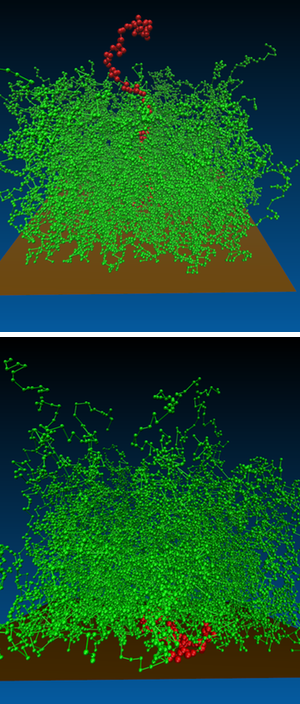Changing Surface Properties in a Flash
Researchers want to develop “smart surfaces” using polymer coatings that would alter their properties in response to environmental changes, such as shifts in temperature, pH level, or light. In Physical Review Letters, a team proposes a new type of polymer coating that they say could change properties in less than a second—faster than any current design. Such quick switching could lead to a variety of uses, such as tiny temperature sensors or medical assays in which cells could be quickly released from a surface on which they are grown.
Many polymer (long-chain) molecules can be attached at one end to a solid surface, creating what looks like bristles on a hairbrush. Such “polymer brushes” allow researchers to control surface properties such as friction or interactions with water. In the last decade or so, they have begun devising brushes that act as switches, enabling a surface to change how it interacts with its surroundings in response to environmental changes. For example, a polymer brush can switch from being repulsive to water, or hydrophobic, to being attracted to water, or hydrophilic, in response to a change in the solvent. Such a switchable brush could coat microscopic particles that could easily disperse in either water or oily liquids without clumping up and without the need for additives to prevent clumping. Adding these kinds of particles can change the properties of the liquid, making it anticorrosive, for example.
This kind of brush consists of roughly equal numbers of hydrophobic and hydrophilic polymers segregated in small clumps throughout the surface. A water-like solvent causes the hydrophilic chains to stretch out because they are more attracted to the solvent than to the surface, while the hydrophobic chains curl up and hug the surface. In this state, the brush acts as a hydrophilic surface, but if you switch to a hydrophobic solvent, the two types of chains swap roles.
The problem with this kind of switch is that it can take minutes to hours to change, says Friederike Schmid of the University of Mainz in Germany. The delay occurs because polymers of the same type tend to entangle with each other, so they need time to untangle themselves before they can fully reorganize.
Schmid and her colleagues have now proposed a polymer brush switching scheme that would work in less than a second. Their theoretical system switches properties in response to a change in temperature, but the same concept could be implemented in other ways, to respond to other types of environmental changes, says Schmid.
The scheme uses a brush containing mostly the same type of polymer, which determines the brush’s default properties. Mixed in are a few chains of a different type that are at least percent longer and that “crouch down” on the surface below a critical temperature but “stand up” at higher temperatures. (Hydrogen bonds between units of the molecule and the surface are less likely at higher temperatures.)
By solving equations for the system and by running computer simulations, the researchers found that a temperature increase of perhaps degrees or less can cause the minority chains to go from crouching down to standing up straight in a time as short as a few milliseconds. Schmid explains that the switch happens rapidly because the minority chains are isolated from each other and act independently; there is no need to wait for the polymers to untangle.
On the other hand, the few minority chains can’t change the surface properties very much without some sort of “amplification,” says Schmid. Other molecules can be attached to the ends of the minority chains to enhance their effect. For example, one could use molecules with a desired chemical reaction—thus producing a surface that goes from neutral to chemically reactive. Or one could attach an antibody to create coated nanoparticles that interact with the body’s immune system. One could even attach fluorescent dyes to make a tiny glowing temperature sensor. In medical assays, a fast polymer brush switch might allow cells to be quickly removed from the surface on which they were grown, in response to, say, an electric field, and avoid the need for chemical treatments.
“It’s certainly a very elegant piece of statistical mechanics and polymer science,” says Marcus Müller of the University of Göttingen in Germany. “It’s nice to see how these principles can be applied to a system that could potentially be important for switching and sensing.”
–Marcus Woo
Marcus Woo is a freelance science writer in the San Francisco Bay Area.





